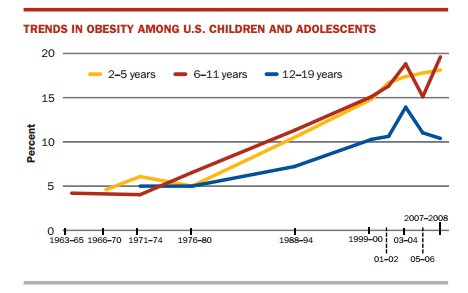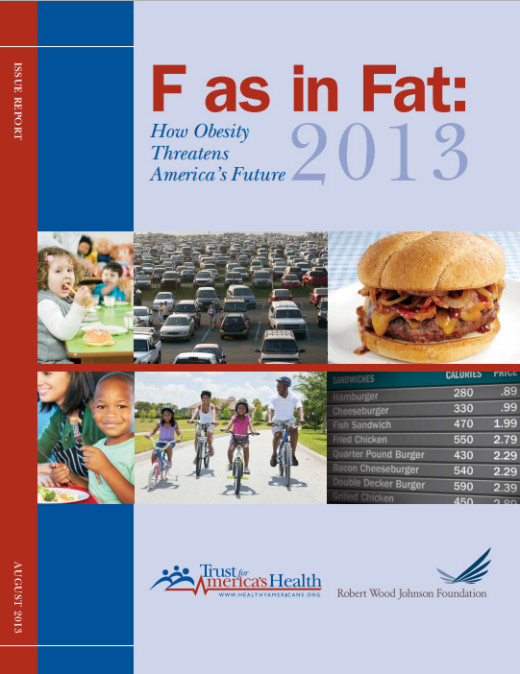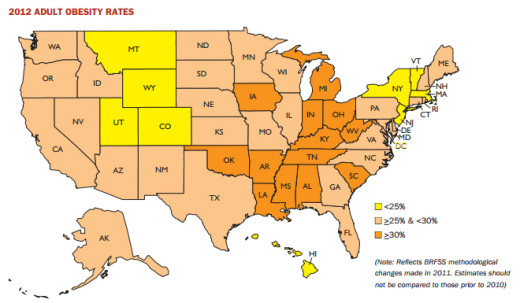HONOILULU, Hawaii – At first glance, a new report released yesterday puts Hawaii in good position as far as obesity rates in America are concerned.
Hawaii ranks 47th out of 51 in the F as in Fat: How Obesity Threatens America’s Future 2013 report put together by the Trust for America’s Health and the Robert Wood Johnson Foundation.
The report summarizes obesity rates in the United States and identifies 13 states with obesity rates above 30 percent and 41 states with rates of at least 25 percent. Every state is above 20 percent.
However, the State Department of Health points out that obesity in Hawaii “continues to increase rapidly consistent with national trends and, without effective interventions, more than half of Hawaii’s adults will be obese by 2030.”
The DOH says according to the report, adult obesity in Hawaii “has increased nearly three times from what it was a little over 20 years ago. In the past year alone, obesity has risen more than seven percent and childhood obesity has also remained high (13.2 percent in 2011).”
From the DOH media release:
| Hawaii’s ethnic diversity also masks significant disparities in obesity that exist in our state with higher rates among native Hawaiians and Pacific Islander populations. While adult obesity in 2011 was 21.9 percent for the overall state, rates ranged from 6.8 percent among Chinese, to 20.6 percent among Filipinos, to 40.8 percent among Native Hawaiians.Not only is obesity in general increasing in Hawaii, but the proportion of adults who are morbidly or excessively obese in Hawaii is also increasing. In 2011, there were 30,000 morbidly obese adults in Hawaii—roughly 3 percent of the population.
Increases in obesity are attributed in-part to physical inactivity and unhealthy eating. Among high school students, only 21 percent met the national recommendations for physical activity. Fruit and vegetable consumption in Hawaii also remains low; the percentage of adults who reported eating more than five servings of fruits and vegetables per day is only 11.4 percent. Among high school students, it was 17.5 percent. Obesity is costly to our state and can lead to diabetes and other chronic conditions later in life. Eighty-two percent of adults in Hawaii have at least one chronic disease, over half have two or more, and 31.5 percent have three or more chronic diseases. Hawaii spends an estimated $470 million annually on obesity-related medical costs, and $770 million on diabetes-related medical costs. |
 Loretta Fuddy, DOH director Loretta Fuddy, DOH director |
|
The Department of Health recently released the Hawaii Physical Activity and Nutrition Plan 2013-2020, a comprehensive set of Hawaii-specific strategies designed to curb the obesity epidemic. The Plan represents the work of community members and stakeholders in obesity prevention from across the state. The plan is available on the Department of Health’s website under “Publications and Campaigns” or via the following direct link.
Meanwhile, the F as in Fat report says Louisiana now has the highest rate of obesity at 34.7 percent, followed closely by Mississippi at 34.6 percent, while Colorado had the lowest rate at 20.5 percent. of the states with the 20 highest adult obesity rates, only Pennsylvania is not in the south or Midwest. Northeastern and Western states comprise most of the states with the lowest rates of obesity.
A disturbing trend illustrated in the national F as in Fat report is the rise in “Extreme Obesity Rates”

The number of extremely obese adults and children also has grown significantly over time. The rate of extremely obese adults grew from 1.4 percent from 1976–1980 to 6.3 percent during 2009–2010.
An individual is considered extremely obese if his or her body mass index (BMI) is greater than or equal to 40, which is roughly the equivalent of being 100 pounds or more above ideal body weight. the number of extremely obese women is nearly twice that of men (8.1 percent versus 4.4 percent). For children and teens ages 2 to 19, severe obesity grew from 1.1 percent among boys and 1.3 percent among girls during 1976 to 1980 to 5.1 percent among boys and 4.7 percent among girls during 1999 to 2006.10, 11 Rates were particularly high among Hispanic boys (9 percent) and non-Hispanic Black girls (12.6 percent).



by Big Island Video News12:42 pm
on at
STORY SUMMARY
HONOILULU, Hawaii – At first glance, a new report released yesterday puts Hawaii in good position as far as obesity rates in America are concerned. Hawaii ranks 47th out of 51 in the F as in Fat: How Obesity Threatens America’s Future 2013 report put together by the Trust for America’s Health and the Robert […]